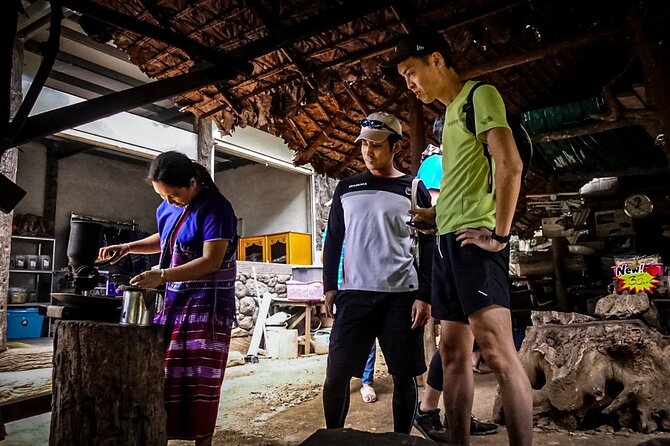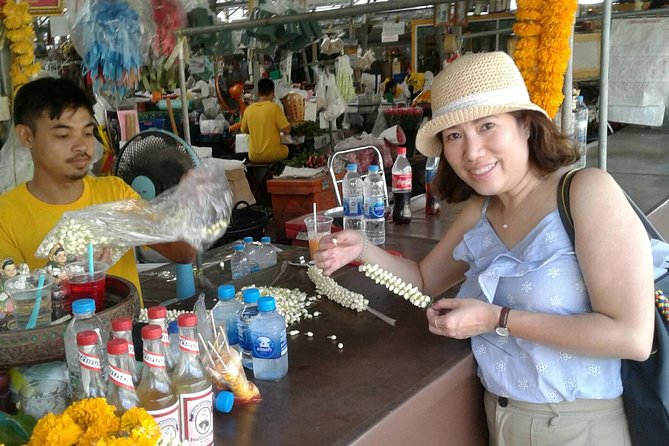The Tea Ceremony Experience in Osaka Doutonbori offers a unique opportunity to immerse oneself in the traditional Japanese art of tea making. Operated by Tea Ceremony Osaka, this cultural activity takes place in the heart of Osaka, near Doutonbori.
Participants can expect a peaceful and educational journey into the world of Japanese tea culture. With an overall rating of 5.0 and positive reviews, this experience promises to be a memorable and enlightening experience.
Key Takeaways
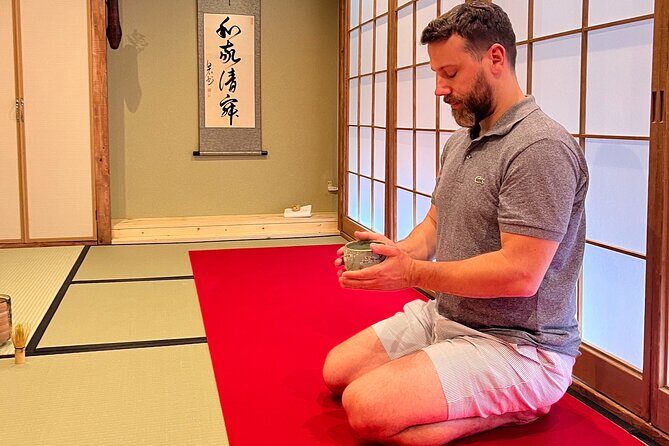
- The tea ceremony in Osaka Doutonbori is a deeply rooted cultural practice with a rich tradition in Japanese history and etiquette.
- The ceremony showcases harmony, respect, and purity through specific rituals and handling of tea utensils.
- The tea ceremony in Osaka Doutonbori reflects Japanese aesthetics and philosophy, emphasizing simplicity and mindfulness.
- Participating in the tea ceremony in Osaka Doutonbori provides a deeper understanding of Japanese culture and cultivates inner peace and appreciation of simplicity.
The Essence of Tea Ceremony in Osaka Doutonbori
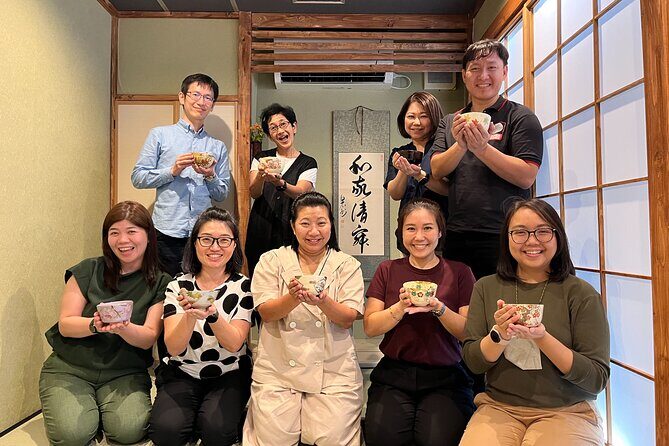
The tea ceremony holds great significance in Japanese culture, and it’s no different in Osaka Doutonbori. The essence of the tea ceremony lies in its rituals and the profound influence it has on Japanese culture.
The tea ceremony is a meticulously choreographed performance that involves the preparation and serving of matcha, a powdered green tea. It embodies principles such as harmony, respect, purity, and tranquility.
The rituals followed during the tea ceremony are meant to create a serene and meditative atmosphere, allowing participants to connect with themselves and others.
The tea ceremony has had a profound influence on Japanese culture, shaping its aesthetics, social interactions, and even the way people appreciate the beauty of simplicity. It’s a window into the heart and soul of Japan.
Unveiling the Art of Japanese Tea Ceremony
The tea master gracefully poured the matcha into the bowl, carefully observing your as they sipped the tea, immersing themselves in the art of the Japanese tea ceremony.
The tea ceremony, with its rich history and cultural significance, is an integral part of Japanese tradition. Dating back to the 9th century, this ancient practice has deep roots in Zen Buddhism and has evolved over time to become a symbol of harmony, respect, and mindfulness.
The ceremony involves a meticulously choreographed ritual, where every gesture and movement holds meaning. From the preparation of the tea to the way it’s served, each step is a reflection of the Japanese aesthetic and philosophy.
Through the tea ceremony, participants not only experience the taste of matcha but also gain a deeper understanding of Japanese culture and its emphasis on simplicity, mindfulness, and connection with nature.
Step Into the Serenity of Osaka’s Tea Ceremony

She gracefully stepped into the serene atmosphere of Osaka’s tea ceremony, immersing herself in the tranquility and mindfulness of the ancient practice.
The tea ceremony etiquette, deeply rooted in Japanese culture, emphasizes respect, harmony, and gratitude.
As she observed the meticulous gestures of the tea master, she realized that the tea ceremony isn’t merely about preparing and serving tea, but also a profound spiritual experience. The benefits of practicing tea ceremony extend beyond the enjoyment of a warm cup of tea. It promotes mindfulness, relaxation, and a sense of inner peace.
Through the art of tea, one can learn patience, precision, and the art of being present in the moment. The tea ceremony encourages a deeper connection with oneself, others, and the natural world, fostering a sense of harmony and balance in daily life.
Exploring the Rich Tradition of Tea Ceremony in Doutonbori

Exploring the rich tradition of tea ceremony in Doutonbori, visitors can enjoy the intricate rituals while savoring the soothing flavors of the carefully brewed tea.
The tea ceremony, known as ‘chanoyu’ or ‘sado,’ is a cultural practice deeply rooted in Japanese history and etiquette. It’s a ceremonial way of preparing and serving tea, showcasing the harmony, respect, and purity that are central to Japanese culture.
The tea ceremony follows a specific set of rituals, including the proper way of greeting, the precise movements when preparing and serving tea, and the way tea utensils are handled. These utensils, such as the tea bowl, tea scoop, and tea whisk, hold great significance and are carefully chosen for their aesthetic and symbolic qualities.
Each utensil contributes to the overall experience, enhancing the beauty and tranquility of the tea ceremony.
Immerse Yourself in the Elegance of Osaka’s Tea Ceremony

Visitors can fully enjoy the elegance of Osaka’s tea ceremony, experiencing the intricate rituals and savoring the soothing flavors of the carefully brewed tea.
The tea ceremony in Osaka is a traditional and highly respected cultural practice. It isn’t only a way to enjoy tea, but also a way to cultivate mindfulness and appreciate the beauty of simplicity.
During the ceremony, guests are expected to follow tea ceremony etiquette, which includes bowing to the host, sitting in a specific manner, and using traditional tea ceremony utensils. These utensils, such as the chawan (tea bowl), chasen (bamboo whisk), and chashaku (tea scoop), are meticulously crafted and hold great significance in the ceremony.
Through the tea ceremony, visitors can gain a deeper understanding of Japanese culture and find inner peace in the serene atmosphere of the tea room.
Frequently Asked Questions
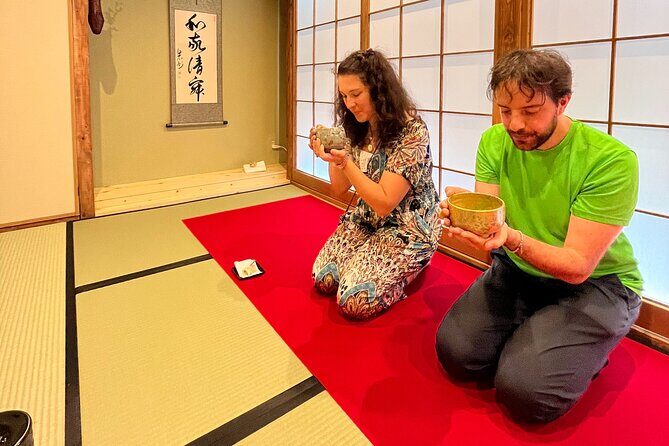
How Many Travelers Are Allowed in the Tea Ceremony Experience in Osaka Doutonbori?
The tea ceremony experience in Osaka Doutonbori allows a maximum of 9 travelers. There are no specific age restrictions mentioned, so it is suitable for both adults and children.
Is the Tea Ceremony Experience Wheelchair Accessible?
The tea ceremony experience in Osaka Doutonbori is not wheelchair accessible. However, for those who cannot consume caffeine, there is an option of caffeine-free matcha milk available.
What Is the Cancellation Policy for the Tea Ceremony Experience in Osaka Doutonbori?
The cancellation policy for the Tea Ceremony Experience in Osaka Doutonbori requires cancellation at least 24 hours in advance for a full refund. Changes made less than 24 hours before start time will not be accepted.
Is There a Specific Meeting Point for the Tea Ceremony Experience?
Yes, there is a specific meeting point for the tea ceremony experience. Guests will be informed of the meeting point upon confirmation of booking. It is important to arrive on time to respect tea ceremony etiquette.
Are There Any Options for Children or Those Who Cannot Consume Caffeine During the Tea Ceremony Experience?
Yes, there are alternatives for children and those who cannot consume caffeine during the tea ceremony. They can enjoy non-caffeinated options such as matcha milk, ensuring everyone can participate in the experience.
The Sum Up
To sum it up, the Tea Ceremony Experience in Osaka Doutonbori offers a unique opportunity for participants to enjoy the traditional art of Japanese tea making. With its convenient location near Doutonbori and easy accessibility via public transportation, participants can easily navigate their way back after the ceremony.
To create internal links in my website, I’ve randomly selected three URL’s from mytasteofasia.com:
-
Khmer Cooking Class at a Local’s Home in Krong Siem Reap: Experience the authentic flavors of Khmer cuisine in a local’s home in Krong Siem Reap.
-
5 Traditional Dishes – Hanoi Cooking Class with Market Trip: Discover the secrets of traditional Hanoi dishes while exploring a local market.
-
Half-day Cooking Class in Thamel, Kathmandu: Learn the art of Nepalese cooking in the heart of Kathmandu’s vibrant Thamel district.
These unique culinary experiences offer a chance to delve into the local food culture and learn traditional cooking techniques. By participating in these classes, travelers can gain a deeper understanding of the local cuisine and create lasting memories.
The Tea Ceremony Experience in Osaka Doutonbori, along with these other cooking classes, promises to be a memorable and enriching experience for all. Participants can indulge in the peaceful and educational atmosphere of the tea ceremony while also exploring the diverse culinary traditions of different regions. Don’t miss out on these exciting opportunities to enjoy the flavors and traditions of Asia.




